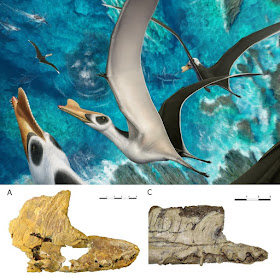 |
Iberodactylus andreui
Holgado, Pêgas, Canudo, Fortuny, Rodrigues, Company & Kellner. 2019
|
Abstract
The pterosaur record from the Iberian Peninsula is mostly scarce and undefined, but in the last few years some new taxa have been described from different Lower Cretaceous sites of Spain. Here we describe a new genus and species of toothed pterodactyloid pterosaur from the Barremian of the Iberian Peninsula, Iberodactylus andreui gen. et sp. nov., that shows a close and rather unexpected relationship with Hamipterus tianshanensis from China. A review of the phylogenetic relationships of the Anhangueria reveals a new family of pterodactyloid pterosaurs, the Hamipteridae fam. nov. being recovered as sister-group of the Anhangueridae. This latter clade can be in turn divided into the new clades Anhanguerinae and Coloborhynchinae. The close relationships of Iberodactylus and Hamipterus shows an interesting palaeobiogeographical correlation between the Chinese and Iberian pterosaur faunas during the Barremian (Lower Cretaceous). The discovery of Iberodactylus strongly suggests that the clade Anhangueria has clear ancestral ties in eastern Laurasia.
Pterosauria Kaup, 1834.
Pterodactyloidea Plieninger, 1901.
Ornithocheiroidea Seeley, 1870 sensu Kellner (2003).
Pteranodontoidea Marsh, 1876 sensu Kellner (2003).
Lanceodontia Andres et al. (2014).
Ornithocheirae Seeley, 1870 sensu Andres et al. (2014).
Anhangueria Rodrigues & Kellner, 2013.
Hamipteridae fam. nov.
Branch-based definition: The most inclusive clade containing Hamipterus tianshanensis, but not Ludodactylus sibbicki, Coloborhynchus clavirostris, and Anhanguera blittersdorffi.
Diagnosis: Crested anhanguerian pterodactyloids with the following synapomorphies: well-defined parallel and forward curved striae and sulci on the anterior region of the premaxillary crest, and an anterior rounded expansion of the anterior margin of the premaxillary crest.
Included species: Hamipterus tianshanensis and Iberodactylus andreui gen. et sp. nov.
Iberodactylus andreui gen. et sp. nov.
Etymology: From the Iberian Peninsula and the Iberian System, where the specimen was recovered, and ‘dactylos’ (δάκτυλος), finger (ancient Greek), a common suffix in pterosaur names; in honour of Mr. Javier Andreu, a local collector who found the fossil.
Holotype: Museo de Ciencias Naturales de la Universidad de Zaragoza (MPZ, Zaragoza, Spain) MPZ-2014/1; an anterior portion of a rostrum, including premaxillae –with a premaxillary crest– and maxillae, both with alveoli and broken teeth.
Horizon and locality: Los Quiñones site, Morenillo limestones of the Blesa Formation, Barremian (Lower Cretaceous), Oliete sub-basin, Iberian Basin. Obón, Teruel Province, Aragón, northeast Spain.
Diagnosis: Hamipterid pterodactyloid with the following autapomorphies: relatively deep premaxillary tip, premaxillary crest with its anterior margin curvature at an angle of about 80°.
Anhanguerinae clade nov.
Stem-based definition: The most inclusive clade containing Anhanguera blittersdorffi but not Coloborhynchus clavirostris.
Diagnosis: Anhanguerids with an enlarged fourth premaxillary tooth, larger than the fifth and sixth teeth and as large as or larger than the third tooth.
Content: Anhanguera, Caulkicephalus, Cearadactylus, Guidraco, Liaoningopterus, Ludodactylus and Maaradactylus.
Coloborhynchinae clade nov.
Stem-based definition: The most inclusive clade containing Coloborhynchus clavirostris but not Anhanguera blittersdorffi or Ludodactylus sibbicki.
Diagnosis: Anhanguerids with a quadrangular expansion of the premaxillary tip and a flat anterior surface of the rostrum24.
Content: Coloborhynchus, Siroccopteryx and Uktenadactylus.
Borja Holgado, Rodrigo V. Pêgas, José Ignacio Canudo, Josep Fortuny, Taissa Rodrigues, Julio Company and Alexander W. A. Kellner. 2019. On A New Crested Pterodactyloid from the Early Cretaceous of the Iberian Peninsula and the Radiation of the Clade Anhangueria. Scientific Reports. volume 9, 4940. DOI: 10.1038/s41598-019-41280-4







